Node Setup and Redundancy
The Hyper Historian installation initializes the Node Setup and Redundancy configuration. Its default settings are for a non-redundant single workstation setup (that is, a non-redundant Hyper Historian Logger with one local Collector).
The Node Setup and Redundancy configuration forms are used to perform any of the following changes:
-
Change the name or description of a Collector or a Logger
-
Add or Delete Remote Collector(s) (Enterprise Edition)
-
Specify the redundancy settings for a Collector (Enterprise Edition)
-
Specify the redundancy settings for a Logging Server (Enterprise Edition)
-
Configure the memory cache size for each collector
NOTE: For additional information about Remote Collectors, refer to the Remote Collectors topic. For information about redundancy for OPC UA servers, refer to the Redundancy Setup Options in Hyper Historian topic.
Collector
To Configure Redundancy and Store-and-Forward Options for a Collector:
-
Start the Workbench, then expand your project. Next, expand the Historical Data node to show the Hyper Historian node. Expand the Hyper Historian node to show the Node Setup and Redundancy node.
-
Right-click Node Setup and Redundancy in the navigation tree and select Add Collector, as shown below, or double-click an existing collector to edit it.
Add Collector from Project Explorer
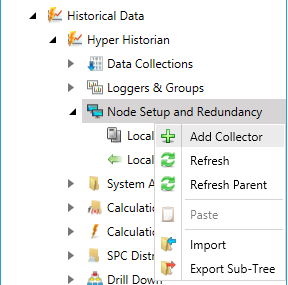
-OR-
Select Node Setup and Redundancy, then click on the Add Collector button, shown below, in the Edit section of the Home ribbon in the Workbench.
Add Collector Button

-
The Hyper Historian Collector Form appears. Enter a name for the collector in the Hyper Historian Collector Name text entry field.
Hyper Historian Collector Form - Properties Tab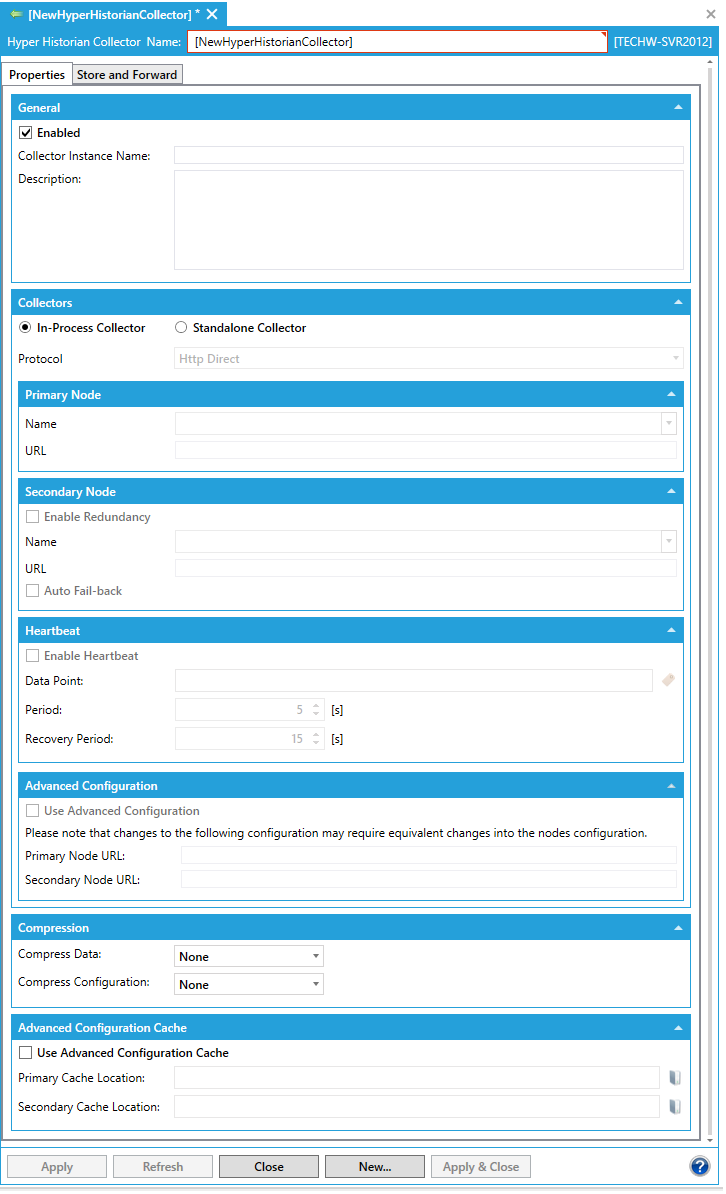
General
-
Ensure that the Enabled check box is checked.
-
Enter a Collector Instance Namein the following text entry field.
-
Enter a Description, making it informative enough so that anyone maintaining the collector will understand its use.
Collectors
-
Next, you select either In-Process Collector (to run the "local" collector) or Standalone Collector (to run the "remote" collector). Click the radio button next to your desired choice.
 Hyper Historian
will not run with Standalone/Remote Collectors if used with a
Standard License. Only users with an Enterprise License can use
this type of collector.
Hyper Historian
will not run with Standalone/Remote Collectors if used with a
Standard License. Only users with an Enterprise License can use
this type of collector. In-Process collectors do not support redundancy.
In-Process collectors do not support redundancy. -
If you selected In-Process Collector, the local collector is used. If you selected Standalone Collector, you must do the following:
-
Use the Protocol drop-down list to select from Http Direct, Tcp Direct, Http over FrameWorX, Tcp over FrameWorX, Https over FrameWorX, WSHttps over FrameWorX, or Use Local FrameWorX as Mediator.
-
Primary Node
-
Enter a Name for the Primary Node or select one from the drop-down list. The URL field is pre-filled from your primary node selection.
Secondary Node
-
You now have the option to click the Enable Redundancy check box within to Secondary Node to identify a backup node in case the primary node becomes unavailable. The following steps assume you have proceeded with configuring a backup node.
-
Enter a Name for the Secondary Node or select one from the drop-down list. The URL field is pre-filled from your backup node selection. (Alternatively, you can use the Advanced Configuration option at the bottom of the form to manually enter the URLs of the primary and secondary nodes.)
-
Click the check box next to Auto Fail-back if you want Hyper Historian to automatically switch from the backup (secondary) node to the primary node when the primary node becomes active again.
Heartbeat
-
Click the Enable Heartbeat checkbox to enable a heartbeat for the given collector.
-
Enter a data point for the heartbeat in the Data Point text entry field or click on the
 button to open the data browser to navigate
to your selected data point.
button to open the data browser to navigate
to your selected data point. -
In the Period text entry field, enter the heartbeat period for failure detection (in seconds).
-
In the Recovery Period text entry field, enter the period for the recovery after heartbeat failure (in seconds).
Advanced Configuration
-
Click the checkbox next to Use Advanced Configuration to manually specify node URLs (and allow further configuration). You can then specify the primary node URL in the Primary Node URL text entry field. If you clicked the Enable Redundancy checkbox in the Secondary Node section, you can also specify the secondary node URL in the Secondary Node URL text entry field.
Compression
-
The Compress Data pulldown menu sets the type of compression of data packages sent from data collector to data logger. This compression can reduce network traffic between these components. None = no compression. Fast = Fast compression using the Deflate algorithm. Optimal = Optimal compression using the Deflate algorithm.
-
The Compress Configuration pulldown menu sets the type of compression of the configuration data sent from logger to collector. None = no compression. Fast = Fast compression using the Deflate algorithm. Optimal = Optimal compression using the Deflate algorithm.
Advanced Configuration Cache
-
Click the check box next to Use Advanced Configuration Cache to manually specify the location of the configuration cache (and allow further configuration). Configuration cache location can be specified separately for the primary and secondary nodes, if needed. To specify primary cache location other than the default, enter it in the Primary Cache Location text entry field or click on the
 button to open the Browse files
or folders window to navigate to your desired location. If you clicked
the Enable Redundancy checkbox in the Secondary Node section, you
can also specify the location of the configuration cache on the secondary
node in the Secondary Cache Location text entry field or click on
the
button to open the Browse files
or folders window to navigate to your desired location. If you clicked
the Enable Redundancy checkbox in the Secondary Node section, you
can also specify the location of the configuration cache on the secondary
node in the Secondary Cache Location text entry field or click on
the  button to open the Browse files or folders
window to navigate to your desired location.
button to open the Browse files or folders
window to navigate to your desired location.
Store and Forward Tab
-
Go to the Store and Forward tab. The Store and Forward feature caches data if the connection to a collector is lost. When the connection to the collector is restored, the cache will be flushed, and the two (primary and secondary) databases will be automatically synchronized.
Hyper Historian Collector Properties - Store and Forward Tab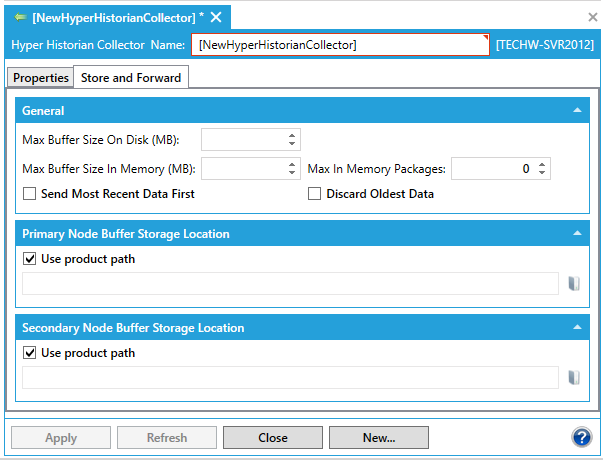
-
Enter your Store and Forward settings, which are:
General
-
Max Buffer Size on Disk (MB) - Enter the maximum disk space (in megabytes) that the buffer can use to store packages.
-
Max Buffer Size in Memory (MB) - Enter the maximum amount of memory that can be used by the data buffer (in megabytes) to store data packages.
-
Max in Memory Packages- Enter the maximum number of data packagers that can be stored in memory. Set to zero for no limit.
-
Send Most Recent Data First- Click this checkbox if you want the most recently collected data to be stored and forwarded before all other data.
-
Discard Oldest Data - Click this checkbox to discard the oldest data first. Leave it empty to discard the newest data first (this is the default selection).
Primary Node Buffer Storage Location
-
Use product path - This checkbox is enabled by default to use the product path as the Buffer Storage Location for the Primary Node. This is the location where data will be queued for storage. Deselecting the checkbox allows you to enter a location in the text entry field that appears or, by clicking on the
 button,
to navigate to a location via the Browse files or folders window.
button,
to navigate to a location via the Browse files or folders window.
Secondary Node Buffer Storage Location
-
Use product path - This checkbox is enabled by default to use the product path as the Buffer Storage Location for the Secondary Node. This is the location where data will be queued for storage. Deselecting the checkbox allows you to enter a location in the text entry field that appears or, by clicking on the
 button, to navigate to a location via the
Browse files or folders window.
button, to navigate to a location via the
Browse files or folders window.
-
Click the Apply button to save your changes.
Note that, alternatively, you can import collector node configuration information from an Excel spreadsheet, an XML file, or a CSV file. For more information, refer to the Importing and Exporting Hyper Historian Configurations topic. Once imported, you can edit imported information as needed.
Logging Server
To Configure Redundancy and Store-and-Forward Options for the Local Logging Server:
-
Start the Workbench, then expand your project. Next, expand the Historical Data node to show the Hyper Historian node. Expand the Hyper Historian node to show the Node Setup and Redundancy node.
-
Expand the Node Setup and Redundancy node. Right-click the Local Logger Server node in the navigation tree and select EditorEdit on a new tab, as shown below.
Edit Local Logging Server from Project Explorer
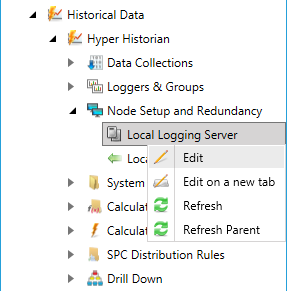
-OR-
Select the Local Logging Server, then click on the Edit button, shown below, in the Edit section of the Home ribbon in the Workbench.
Edit Button

This opens the Local Logging Server properties, as shown below.
Local Logging Server Properties
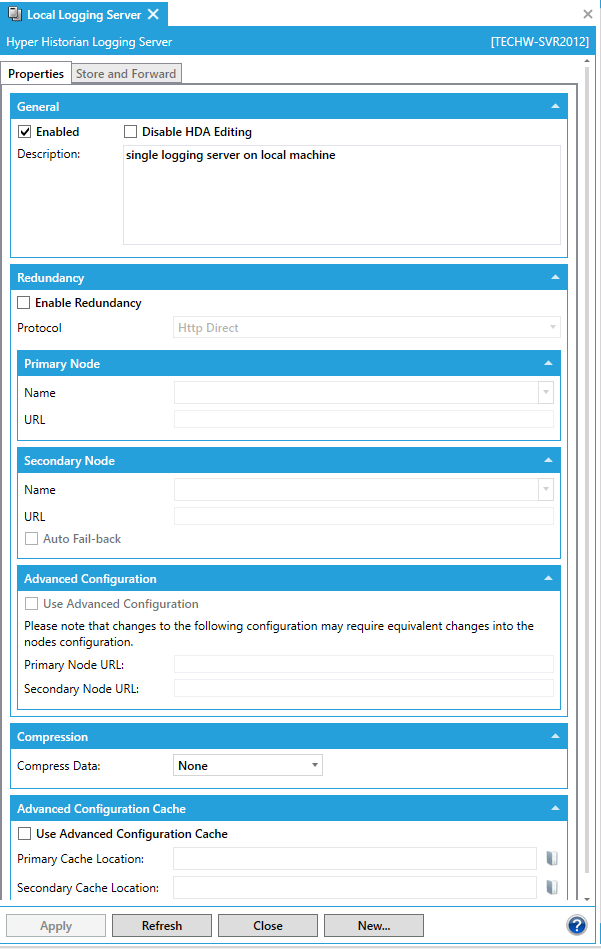
General
-
Ensure the Enabled check box is checked.
-
Optionally, to make the server's historical data read-only, put a check mark in the Disable HDA Editing check box. If you do this, you won't be able to edit any Historical data being logged on the server using any programmatic interfaces.
-
Enter the optional Description, if desired.
Redundancy
-
To use redundancy, click the check mark next to EnableRedundancy to enable it, and follow these steps:
-
Use the Protocol drop-down list to select from Http Direct, Tcp Direct, Http over FrameWorX, Tcp over FrameWorX, Https over FrameWorX, WSHttps over FrameWorX, or Use Local FrameWorX as Mediator.
Primary Node
-
Enter a Name for the Primary Node or select one from the drop-down list. The URL field is pre-filled from your primary node selection.
Secondary Node
-
You now have the option to click the Enable Redundancy check box within to Secondary Node to identify a backup node in case the primary node becomes unavailable. The following steps assume you have proceeded with configuring a backup node.
-
Enter a Name for the Secondary Node or select one from the drop-down list. The URL field is pre-filled from your backup node selection. (Alternatively, you can use the Advanced Configuration option at the bottom of the form to manually enter the URLs of the primary and secondary nodes.)
-
Click the check box next to Auto Fail-back if you want Hyper Historian to automatically switch from the backup (secondary) node to the primary node when the primary node becomes active again.
Advanced Configuration
-
Click the checkbox next to Use Advanced Configuration to manually specify node URLs (and allow further configuration). You can then specify the primary node URL in the Primary Node URL text entry field. If you clicked the Enable Redundancy checkbox in the Secondary Node section, you can also specify the secondary node URL in the Secondary Node URL text entry field.
Compression
-
The Compress Data pulldown menu sets the type of compression of the data packages sent to peer logger. As such, it can reduce network traffic between redundant loggers. None = no compression. Fast = Fast compression using the Deflate algorithm. Optimal = Optimal compression using the Deflate algorithm.
Advanced Configuration Cache
-
Click the check box next to Use Advanced Configuration Cache to manually specify the location of the configuration cache (and allow further configuration). You can specify the location of the configuration cache on the primary node by entering it in the Primary Cache Location text entry field or click on the
 button
to open the Browse files or folders window to navigate to your desired
location. If you clicked the Enable Redundancy checkbox in the Secondary
Node section, you can also specify the location of the configuration
cache on the secondary node in the Secondary Cache Location text entry
field or click on the
button
to open the Browse files or folders window to navigate to your desired
location. If you clicked the Enable Redundancy checkbox in the Secondary
Node section, you can also specify the location of the configuration
cache on the secondary node in the Secondary Cache Location text entry
field or click on the  button to open the Browse files or folders window to navigate to your
desired location.
button to open the Browse files or folders window to navigate to your
desired location.
Store and Forward Tab
-
When redundancy is enabled, Store and Forward buffer can be configured in the Store and Forward tab. The Store and Forward buffer feature stores data packages until these are safely stored by connected peer server. When the connection to the peer logger node is restored, the buffer will be flushed, and the primary and secondary logger nodes will be automatically synchronized.
Hyper Historian Local Logging Server Properties - Store and Forward Tab
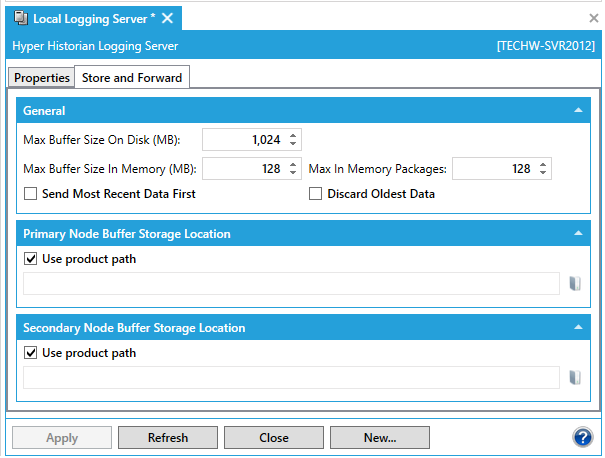
-
Enter your Store and Forward settings, which are:
General
-
Max Buffer Size on Disk (MB) - Enter the maximum disk space (in megabytes) that the buffer can use to store packages.
-
Max Buffer Size in Memory (MB) - Enter the maximum amount of memory that can be used by the data buffer (in megabytes) to store data packages.
-
Max in Memory Packages- Enter the maximum number of data packagers that can be stored in memory. Set to zero for no limit.
-
Send Most Recent Data First- Click this checkbox if you want the most recently collected data to be stored and forwarded before all other data.
-
Discard Oldest Data - Click this checkbox to discard the oldest data first. Leave it empty to discard the newest data first (this is the default selection).
Primary Node Buffer Storage Location
-
Use product path - This checkbox is enabled by default to use the product path as the Buffer Storage Location for the Primary Node. This is the location where data will be queued for storage. Deselecting the checkbox allows you to enter a location in the text entry field that appears or, by clicking on the
 button,
to navigate to a location via the Browse files or folders window.
button,
to navigate to a location via the Browse files or folders window.
Secondary Node Buffer Storage Location
-
Use product path - This checkbox is enabled by default to use the product path as the Buffer Storage Location for the Secondary Node. This is the location where data will be queued for storage. Deselecting the checkbox allows you to enter a location in the text entry field that appears or, by clicking on the
 button, to navigate to a location via the
Browse files or folders window.
button, to navigate to a location via the
Browse files or folders window.
[Click HERE for more info on Store and Forward settings.]
-
Click the Apply button to save your changes.
Note that, alternatively, you can import logging server configuration information from an Excel spreadsheet, an XML file, or a CSV file. For more information, refer to the Importing and Exporting Hyper Historian Configurations topic. Once imported, you can edit imported information as needed.
See Also: